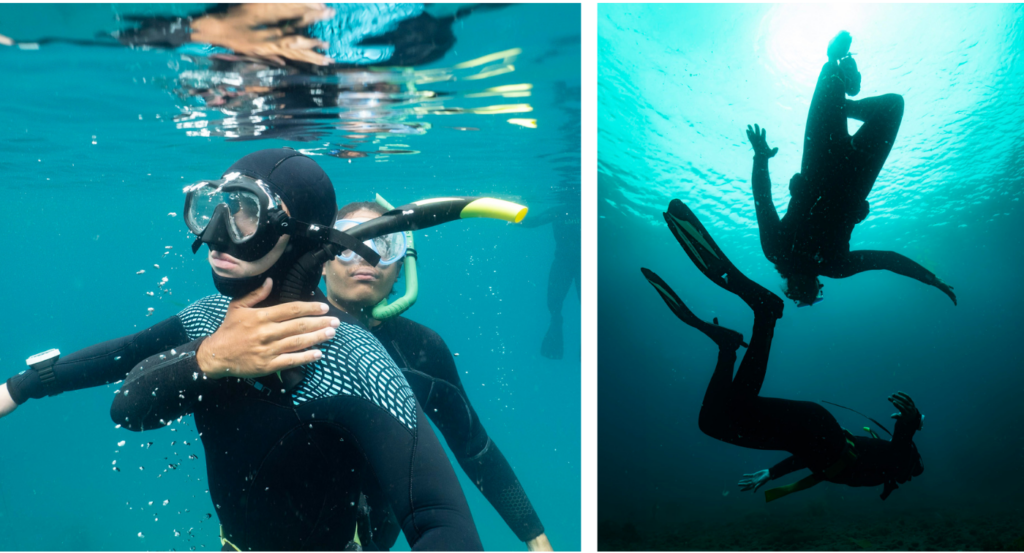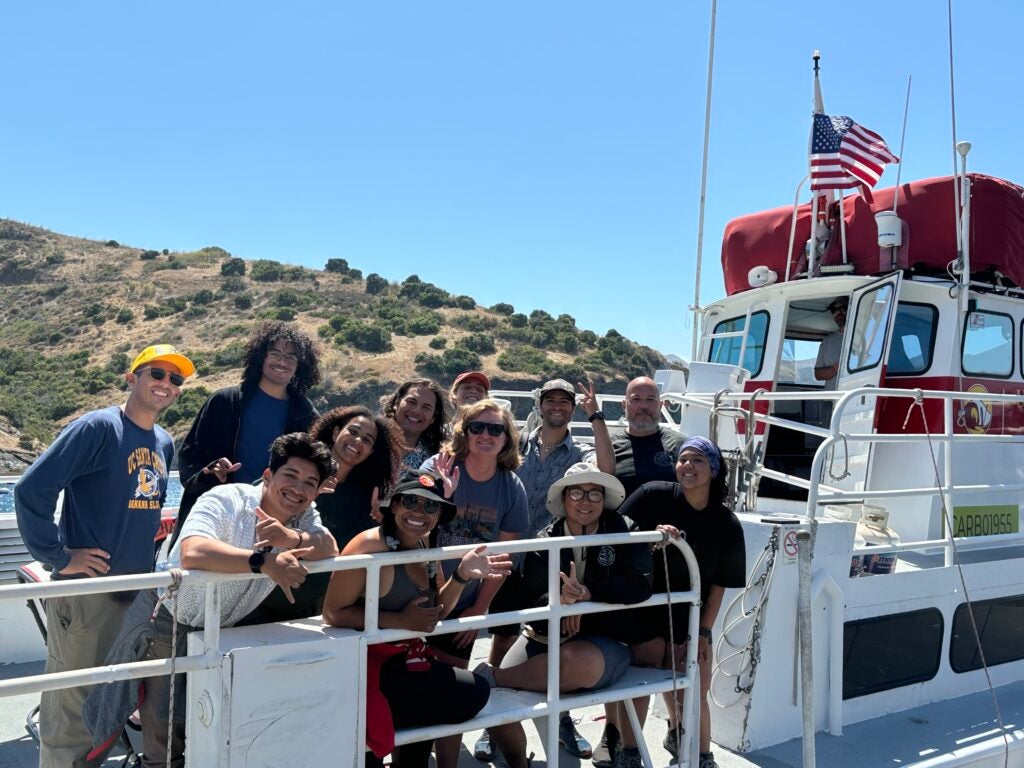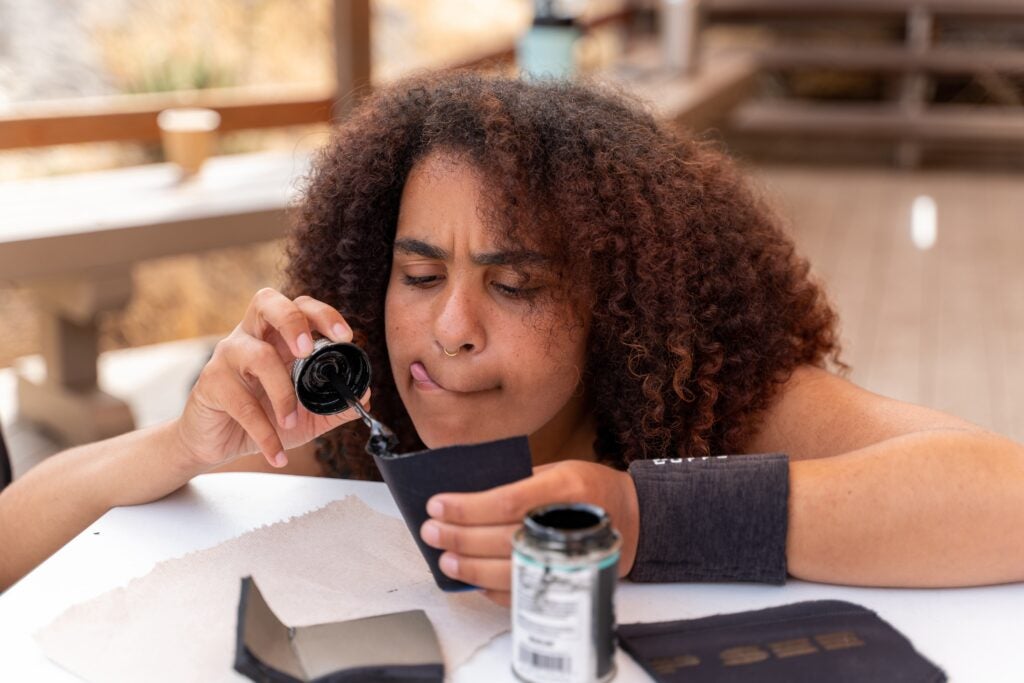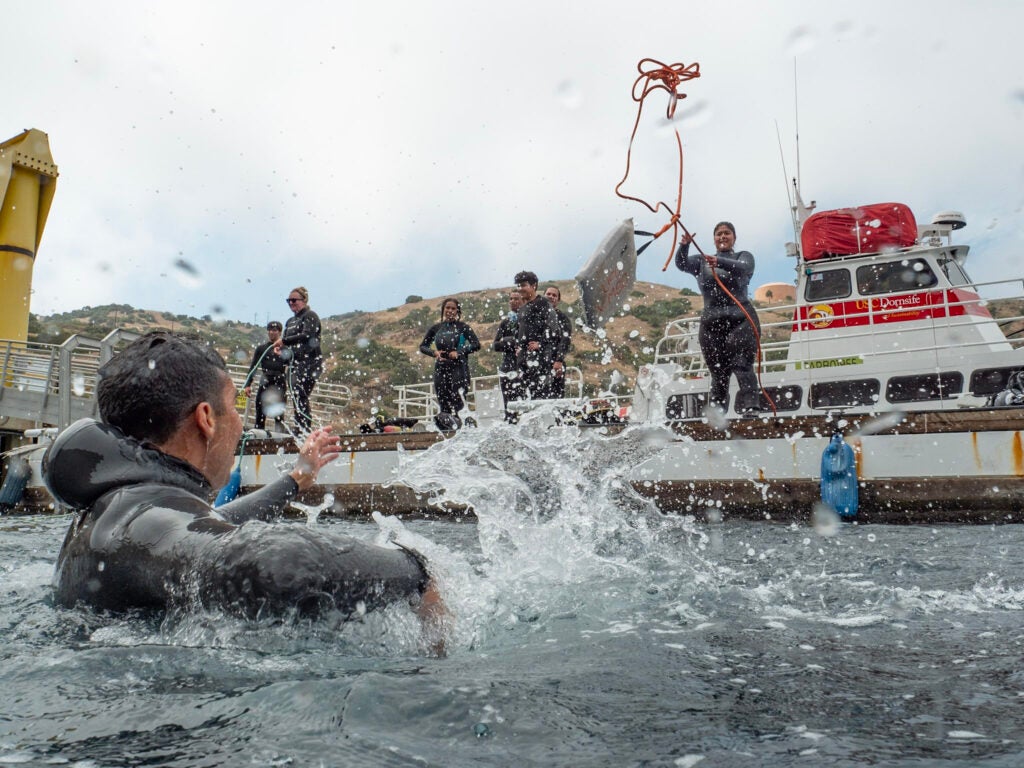
Scientific divers-in-training learn how to conduct underwater transects (a technique for dividing up real-world environments into measurable sections) and other skills for safely collecting and accurately recording data on marine habitats. (Courtesy of Yurika Tomita)
Breaking Barriers: Students share their journeys in scientific diving
What if you could explore the wonders of the underwater world while learning how to make an impact in marine science? That’s what seven students, all from backgrounds traditionally underrepresented in the field, did this summer through the USC Wrigley Institute for Environment and Sustainability’s Scientific Diving Discovery Program (SDDP).
Scientific diving, or scuba diving conducted for scientific research, enables researchers to gather crucial data and better understand one of our planet’s most important ecosystems. Historically, however, scientific diving has been accessible only to a limited number of people. Barriers include the high financial costs of training, lack of access to proper equipment, and the need for prior swimming and diving experience.
These barriers matter because, without scientific diving certification, aspiring marine scientists are often unable to access internships, graduate programs, and jobs in the field. SDDP seeks to bridge the gap by training Southern California-based STEM undergraduates from underrepresented backgrounds in the fundamentals of scuba diving and underwater research.
Upon successful completion of the program, which takes place at the Wrigley Marine Science Center on Catalina Island, participants earn their American Academy of Underwater Sciences (AAUS) Scientific Diving authorization. The authorization, alongside ongoing mentorship and professional development opportunities from SDDP, opens pathways for students to achieve educational and career goals in ocean science, conservation, and other related fields.
Keep scrolling to read students’ takeaways from this year’s SDDP.

Ryn Heier, California State University Fullerton
SDDP was an unbelievable opportunity. Not only did it offer the scientific diving certification, but it also offered certification in lead scientific diving, advanced open water recreational diving, diving first aid, and rescue diving, as well as a boater’s license and career and professional development, all at no cost. Without this program, I would not have been able to afford these certifications, and I also would never have met a wide variety of marine professionals that can help direct my career goals after college. Through this program, I have been exposed to so many options, potential career paths, and have been encouraged to explore my own interests in unusual places.
Being a part of this program has also made me more confident in my own abilities and my own right to be here. I have always suffered from feeling like an outsider who exists in places I’m not supposed to be in, but this program has reminded me that science is for everyone, and that everyone has a right to be curious. This program encouraged questions and curiosity, and learning in a way that academia doesn’t always allow. It encouraged me to make mistakes and learn from them and be better next time. Ultimately, it encouraged me to learn who I am and who I want to be.
Fiona Hewitt, University of Southern California
I was born with a profound love for the ocean. My parents would often complain about how stubborn I could be, staying in the pool or ocean until my skin was wrinkly, screeching to be let back in when they were finally able to pull me out. Living in landlocked cities throughout my childhood, my access to water was limited to summers when we could get away from the hustle and bustle of the city and travel to the coasts. For the longest time, I felt I had to relegate my love for the ocean to a fun summer hobby. I couldn’t see a career path that would allow me to interact with bodies of water until I discovered the world of underwater archaeology.
The AAUS certification will allow me to participate in research dives of wrecks, hopefully learning essential archaeology skills like photogrammetry. In addition to the AAUS authorization, we received the NAUI Rescue diver certification, a prerequisite for most volunteer diving positions. This certification opens so many doors to continue diving.
I’ve often said, “If I could live in the ocean, I would,” and this program let me get one step closer to making that former impossibility a reality.
Joshua Sheldon, Orange Coast College
It would be easy for me to say that the certifications are the most beneficial thing about this program. But, I did some thinking and I determined that the most valuable part of the program was the training environment. For me to perform at the best of my ability, I need the right environment. The SDDP environment was strenuous, but also focused. The rate that this program moved created constant engagement; it was an ongoing process of creating new skills that build off of foundational skills. The education provided to me has been exceptionally attentive to detail, and I feel as if we’ve left no stone unturned.
The people around me expected a lot from me, and they pushed me to my limits. The dive staff (Anesti, Tony, Kelly, Audrey, Kian, Cora, Yurika, and Nick) provided me with the safety net needed in order to try, fail, and try again. Our program coordinator, Marcela, as well as my fellow cohort members, provided me with the social and emotional safe space to reach out, express myself, make mistakes, and correct them. All of these things came together in SDDP to provide an excellent opportunity for learning and self-improvement.

Christina Hernandez, Citrus College
I jumped at the opportunity to be a part of SDDP, seeing that I struggle financially between work and school. I knew it would be almost impossible for me to continue my education and pursue any kind of scuba diving certification due to the multiple levels of certifications needed, the immense cost of diving courses, and the equipment needed to be a diver–let alone become an AAUS diver. I hope that having these certifications will make me stand out to employers and organizations with similar goals, furthering my journey to a career in the ocean. My future in research will not be limited to a classroom, laboratory, or a land mass: I will be able to conduct research in both land and sea settings with my prior experiences and the skills I gain from the program.
The most surprising thing I learned during this month-long program was the importance of building a community with like-minded individuals. Spending 30 days, day and night, with my cohort has been life-changing; I would have never imagined having this type of connection and support with people from such different backgrounds. These people have helped me grow my self-confidence. Before starting the program, I thought it would be impossible for me to meet the expectations and requirements for diving. Although we all struggled with certain things–whether mentally, physically or emotionally–everyone pushed each other to persevere through our endeavors and stay determined in our journey to becoming AAUS divers. I am thankful for the support and positive reinforcement from both my cohort and the staff that helped us through everything.
Artemio Del Toro, California State University Long Beach
Learning how to scuba dive is helping me form a path to repay the ocean for all it’s given me. With my AAUS certification, I aim to study abalone, their behavior, and how we can conserve them. Specifically, it is a dream of mine to be able to work with White Abalone Conservation Project, focused on growing populations.
Being part of SDDP was one of the best ways to help me progress with this goal. I knew it would be a good choice for me because of the holistic approach to diving scientifically. The program has a philosophy of meeting people where they are at, and I think that this lifted a lot of the worries I had about scientific diving. I was also surprised to learn just how much of this program is dedicated to growing us as young professionals in our fields. Building skills here with our cohort and mentors gives us so much insight into how we can keep moving in the right direction.

Daniel Josue Carcamo, California State University Northridge
Scientific diving allows me to better understand the kind of research I can do and how I can turn my ideas into something doable. SDDP helped me begin taking the steps needed to become a marine environmentalist, as well as showed me the different paths I can take with this career. The program gave me the opportunity to further improve my skills as a scientist and student, and to further discover the type of person I am and want to be. It also helped open the doors for me to begin learning more about diving research and work that I thought I wouldn’t be able to do due to financial restraints. Moreover, this program has reinforced the idea that connections are one of the most important part of scientific careers; I am grateful it has helped me expand my network through the people I met with the program, whether they be instructors, speakers, or my cohort mates.
Kevin Antoine, San Francisco State University
The program has significantly improved my underwater diving proficiency and confidence. This training has enhanced my ability to safely perform lengthy and complex dives, and as a newly certified AAUS diver, I have gained a new level of confidence. More than anything else, the collaborative structure of this program has allowed me to work closely with seasoned academics and peers—something I had not had the privilege of doing since before the COVID-19 pandemic. To sum up my feelings and experience with SDDP, the experience was a once-in-a-lifetime opportunity to better myself as a diver, collaborate, and get to know so many other people my age with fascinating experiences, fields of study, and aspirations who I will stay connected with for the rest of my life.
